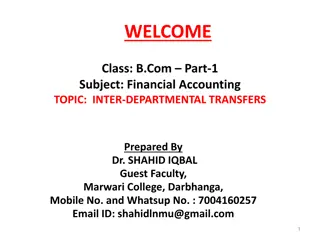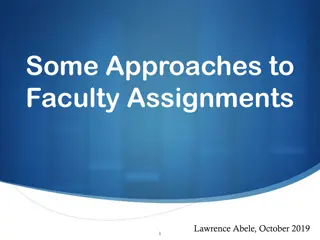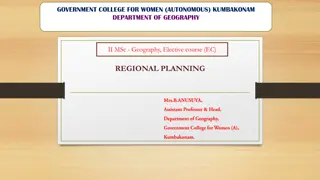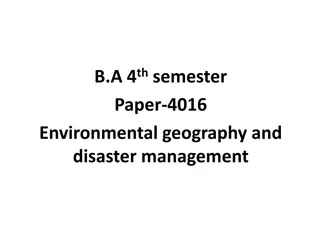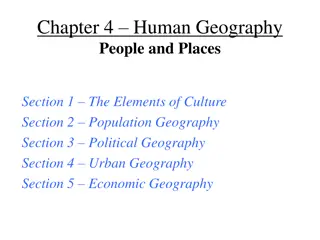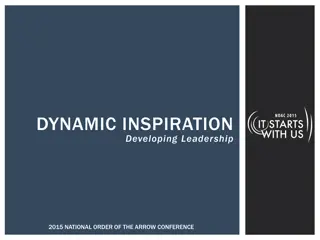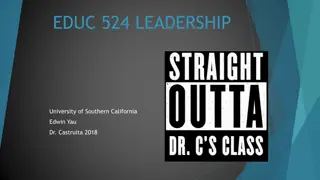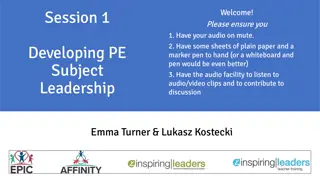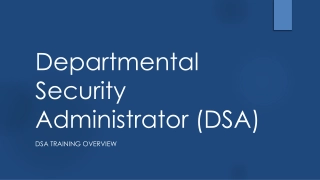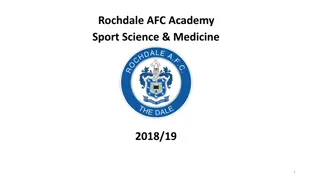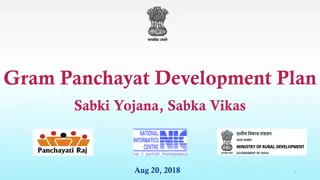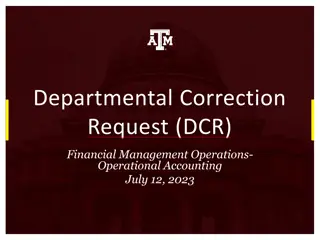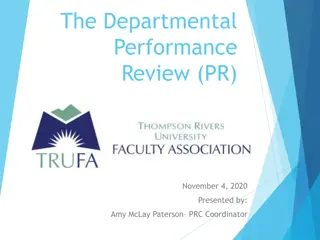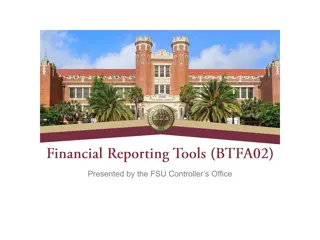Navigating Departmental Leadership as Head of Geography
As the Head of Geography, the journey involves transitioning between schools, managing staff, setting priorities, and fostering a clear vision for the department. Embracing effective leadership, defining goals, and ensuring staff alignment are key for success in navigating departmental complexities.
Download Presentation

Please find below an Image/Link to download the presentation.
The content on the website is provided AS IS for your information and personal use only. It may not be sold, licensed, or shared on other websites without obtaining consent from the author. Download presentation by click this link. If you encounter any issues during the download, it is possible that the publisher has removed the file from their server.
E N D
Presentation Transcript
Being Head of Geography: Being Head of Geography: navigating the complexities of navigating the complexities of departmental leadership departmental leadership www.katestockings.com stockings.geography@gmail.com
My context September 2015 Started as an NQT at School 1. February 2016 Took over as HOD at School 1. July 2018 Left School 1 after 3 roller-coaster years. September 2018 Started as HOD at School 2. Joined by 2 NQTs. One very experienced geographer already at the school (~15 years) April 2021 Next step? TBC.
Reflection Task What do Heads of Department do? Task from Graeme Eyre (@gceyre) Task
Reflection Task What do Heads of Department do? Task from Graeme Eyre (@gceyre) Task More? Less? Same? Barriers? What if I did not do?
Part 1: The Big Picture Leadership defines the destination. Management gets us to the destination.
Keep the main thing the main thing I have heard political leaders say that you cannot have the word priority in the plural. It s a statement to reflect on. Does your school have too many priorities ? Do staff think you have? Wise school leaders may well present a number of priorities for the academic year, but they ensure first that there is sufficient capacity to follow through on these priorities. If leaders don t offer focus, and begin to wander from their intended path, staff will wander too. Energies will be dissipated, morale weakened, whole-staff commitment to the cause dented. And students will sense it. Reassure yourself that no organisation can do everything it wants to, all of the time. (p.20)
The importance of a vision The dangers of no real vision as HOD: Difficult to move departmental meetings beyond discussing admin A risk of a lack of coherence between different schemes of work A risk of a lack of progression (particularly across KS3)
The importance of a vision Often, the inexperienced eye will only see the surface features. They don t think about why something is in place. So, they need multiple concrete examples or explanations. We need to share the thinking beneath the plan. We need to share the thought beyond the vision and the rationale.
Part 1: The Big Picture Lesson 1: The importance of a vision What is your destination? What are you aiming for? Lesson 2: Actively sharing that vision and your thinking Why are you doing what you re doing? What is behind your thinking and any resultant changes?
Part 1: The Big Picture How do you know in education if you ve shared your vision successfully? Can you hold someone to account if you haven t adequately shared your vision?
Tighten up to be good, loosen to be excellent On a school improvement journey, tighten the systems and the expectations- and good provision will be realized. On the journey to excellent, by all means loosen - but don t stop tightening. It s not an either / or. Choose carefully which aspects of the organisation can be loosened, or the previous gains will be compromised. (p.36)
Part 1: The Big Picture Lesson 1: The importance of a vision What is your destination? What are you aiming for? Lesson 2: Actively sharing that vision and your thinking Why are you doing what you re doing? What is behind your thinking and any resultant changes? Lesson 3: Tightening is important but loosening is equally so.
Part 2: The Complexities Should departmental middle managers be participants in whole-school strategic decision- making and policy making, or is their role to be the faithful implementers of others policy decisions? (Bennett, 1999)
Part 2: The Complexities Does the Head of Department have to be the best teacher of that subject?
Part 2: The Complexities From Bennett, 2007: Some SLT stated that subject leaders used administration as a refuge to avoid the awkwardness of entering the classroom of another teacher to engage in monitoring. This tension between monitoring and professionalism has to be acknowledged and resolved by the middle leader. Consequently, informal and other strategies are employed to monitor colleagues work.
Part 2: The Complexities Lesson 1: The importance of a vision What is your destination? What are you aiming for? Lesson 2: Actively sharing that vision and your thinking Why are you doing what you re doing? What is behind your thinking and any resultant changes? Lesson 3: Tightening is important but loosening is equally so. Lesson 4: Wherever possible, be transparent in your rationale for doing things. Build up trust in the team by explaining why you re doing what you re doing.
Part 2: The Complexities From Irvine, P. and Brundrett, M. (2016) Newly appointed middle leaders aspire to change things for the better, but then can feel constrained by the habitual behavior of the organization or members of their department. When asked what the hardest thing was about the role, a significant number of the participants responded that it was their departmental members. On closer inspection, there may be 2 reasons for this: People see things differently There are people in the department who are at different stages of their career
Lessons Learnt Lesson 1: The importance of a vision What is your destination? What are you aiming for? Lesson 2: Actively sharing that vision and your thinking Why are you doing what you re doing? What is behind your thinking and any resultant changes? Lesson 3: Tightening is important but loosening is equally so. Lesson 4: Wherever possible, be transparent in your rationale for doing things. Build up trust in the team by explaining why you re doing what you re doing. Lesson 5: Take the time to work out the identities of those in your team. How do they see the department? The school? Where are they in their career?
Part 3: Two different experiences of HOD life Experience A Experience B Priority has to be day-to-day or half-term to half-term firefighting Able to move to term-by-term planning. Able to see KS3 as a journey. Able to see the 7-year journey. No real vision because the big picture is clouded by the day to day. The vision is to teach the best lessons possible but no real thought as to what this looks like long term. Lots of consideration of vision: where do you want the department to end up and why? What has been achieved? What still need to be achieved? Management of the team: doing everything you can to get to achieve improvements yet improvements not really defined. Leadership of the team: knowing the end goal and helping develop staff to get there. Lack of headspace to think big . Limited time to read, reflect and plan. More headspace to think big . Increasing time to read, reflect and plan.
Part 3: Two different experiences of HOD life Lesson 6: A set departmental meeting is essential. Even if the whole hour is not used, it must be there. Preparation for this meeting is essential. Whatever form that may take. Beyond this meeting, are you a talking department? Is there a constant interchange of professional information at a formal and informal level? How do you foster this?
Lesson 7: Realise how important autonomy is to you and provide others the same.
Lesson 7: Realise how important autonomy is to you and provide others the same.
Lessons Learnt Lesson 1: The importance of a vision What is your destination? What are you aiming for? Lesson 2: Actively sharing that vision and your thinking Why are you doing what you re doing? What is behind your thinking and any resultant changes? Lesson 3: Tightening is important but loosening is equally so. Lesson 4: Wherever possible, be transparent in your rationale for doing things. Build up trust in the team by explaining why you re doing what you re doing. Lesson 5: Take the time to work out the identities of those in your team. How do they see the department? The school? Where are they in their career? Lesson 6: A set departmental meeting is essential. Lesson 7: Realise how important autonomy is to you and provide others the same.
Being Head of Geography: Being Head of Geography: navigating the complexities of navigating the complexities of departmental leadership departmental leadership www.katestockings.com stockings.geography@gmail.com





